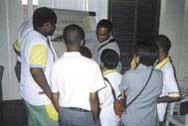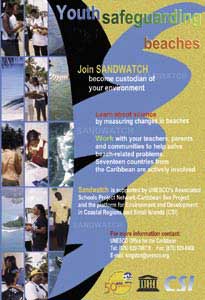|
|
Coastal region and small island papers 19
1
1 First UNESCO Associated Schools Caribbean Sea Project Regional Environmental Education Workshop, 21–26 July 1998, held in Tobago in 1998.
(CORALINA is the Corporation for the
Sustainable Development
of the Archipelago of San
Andres, Old Providence
and Santa Catalina.)
Summary
Sandwatch provides the framework for school students, with the help
of their teachers and local communities, to work together to critically
evaluate the problems and conflicts facing their
beach environments and
to develop sustainable approaches to address these issues. With a strong
field monitoring component, Sandwatch tries to ‘make science live’, yet
remains inter-disciplinary with applications ranging from biology to
woodwork and from poetry to mathematics. Documenting the Sandwatch
methods is the major focus of this publication. An activities-orientated
approach is used to provide step-by-step instructions to cover topics
such as observation and recording,
erosion and
accretion, beach
composition, human activities, beach debris, water quality, waves,
longshore currents, plants and animals. The activities are related to
sustainable development issues including: beach ownership; mining
beaches for construction material; conflict resolution between different
beach users; preparing for
global warming, sea level rise,
hurricanes
and tsunamis;
pollution; and conservation of endangered species.
Finally, two success stories of Sandwatch are presented that show how
students have applied their school-based learning to everyday life,
enhanced their critical thinking and conflict resolution skills and,
perhaps most importantly, developed a sense of ‘caring’ for their
beaches – their environment.
Background
A group of teachers and students met in Tobago in July 1998 for an
Environmental Education workshop1. They
saw firsthand many of the problems facing the coastal zone – problems
related to erosion,
pollution and development – and resolved to do
something about these issues themselves. This was the beginning of what
has become known as
Sandwatch.
Among the resource persons at the Tobago workshop was Ms Bebe Ajodha,
and much
of the following insight about environmental education comes from her
presentation
(UNESCO, 1998).
Environmental education is a process aimed at developing a world population that is aware of, and concerned about, the total environment and its associated problems, and which has the knowledge, attitudes, skills, motivation and commitment to work individually and collectively towards solutions of current problems and the prevention of new ones.
More than just science, environmental education requires an understanding of economics, mathematics, geography, ethics, politics, and history. Moreover, addressing the interaction between humans and the environment is critical, making it necessary to incorporate subjects such as human ecology, philosophy, psychology and language.
It is not necessary to be a scientist or an environmental education professional to incorporate environmental education into teaching. Rather, it is a case of facilitating learning, and knowing how and when to get other teaching colleagues and experts involved. Environmental education is much more than teaching one subject; it involves decision-making, communication and creative skills – in other words, it is education for life. Venturing into unknown areas and learning about issues along with the students are other exciting aspects of environmental education.
Getting the students outside and away from the more formalized classroom surroundings helps them gain first-hand experience of their community, their natural environment and the issues facing both. In so doing, they benefit from a more ‘hands on’, practical or discovery learning approach.
Through Sandwatch, school students, with the help of local communities, get involved in the enhancement and wise management of their beach environments.
| VISION STATEMENT Sandwatch seeks to change the lifestyle and habits of youth and adults on a community-wide basis, and to develop awareness of the fragile nature of the marine and coastal environment and the need to use it wisely. |
The beach environment was selected as the focus area for Sandwatch since beaches are much treasured by island and coastal residents and they represent areas of rapid change over short time periods.
With a strong field monitoring component, Sandwatch tries to ‘make science live’, yet remains inter-disciplinary with applications ranging from biology and ecology to woodwork and from poetry to mathematics. The long-term goal is to have Sandwatch activities integrated into the school curriculum so that it becomes a flagship project in this Decade of Education for Sustainable Development (2005–2014).
Sandwatch activities relate directly to topics already included in the primary and secondary school curricula. For instance at the primary level they can be incorporated directly into:
- language arts: writing, reading, comprehension, composition, poetry;
- mathematics: both mechanical and problem solving;
- social studies;
- health education;
- basic science;
- arts – music, drawing, drama.
Also, at secondary school level they can be incorporated into language studies, science (biology, chemistry, physics), mathematics, social studies, geography and others. To take just two specific examples, the Caribbean Examinations Council Secondary Education Certificate for Biology (Section A) covers living organisms in the environment – see Chapter 11 of this publication; and Section B of the Social Studies syllabus includes the development and use of resources – see particularly Chapter 5 in this publication.
 |
|
| Sandwatch is also about sharing information. Here a group of students in San Andres discuss how to measure beaches with a representative from CORALINA |
|
 |
|
| Other
representatives from CORALINA talk with a beach user on how to best protect an eroding beach, 2003.
|
- involve school students (primary and secondary school students) in the scientific observation, measurement and analysis of beaches utilizing an inter-disciplinary approach;
- assist school students, with the help of local communities, in applying their information and knowledge to the wise management and enhancement of their beaches;
- reduce the level of pollution in adjoining seas and oceans.
Sandwatch equips students with the skills to:
- make observations of the beach;
- carry out simple measurements of different beach characteristics, specifically: erosion and accretion; sand composition; waves, currents and longshore transport; biological fauna and flora; water quality; human activities; beach debris and litter;
- repeat and record these measurements accurately over time;
- compile and analyse the data;
- interpret the data, and prepare reports, graphs, stories, poems, artwork depicting the results;
- provide information to government agencies and interested parties where appropriate;
- select beach issues to address and, together with their communities, implement beach enhancement projects.
Short history and scope of Sandwatch
The concept of Sandwatch developed during the First UNESCO Associated Schools Project Network (ASPnet) Caribbean Sea Regional Environmental Education Workshop, held in Tobago, 21–26 July 1998. Thereafter, UNESCO’s ASPnet joined partners with its platform for Environment and Development in Coastal Regions and in Small Islands (CSI) to prepare a proposal for a Sandwatch project. The following year, 1999, the proposal was officially endorsed at the Fourth Regional Coordinators Meeting of the UNESCO ASPnet Caribbean Sea Project, held in St Vincent and the Grenadines, 25–27 May 1999.
The project formally began in 2001 with the First Regional Workshop.
With the support of the
St Lucia National Commission for UNESCO, teachers from 18 Caribbean
countries took part in a three-day workshop in St Lucia from 31 May to 2 June 2001 and
were joined by students from seven St Lucian secondary schools. The main purpose of the
workshop was to train the teachers in various beach monitoring methods relating to
erosion and accretion, wave action, water quality and human beach activities. A manual was
prepared prior to the workshop and was distributed to the participants. Classroom and
beach sessions were
integrated to demonstrate the various techniques. Sufficient equipment
kits were distributed to the participating countries, so that at least three schools from each
country could get involved in the monitoring activities. A project implementation plan was also
prepared, which included scheduling a second workshop in Dominica in 2003 to share the results of
the monitoring.
Over the next two years, the teachers who attended the St Lucia workshop shared the Sandwatch techniques and skills with their students, as well as with teachers from other schools, and together they embarked on programmes to monitor their beach environments.
Then in July 2003, with the added support of UNESCO’s field offices in Kingston, Apia and Dar-es-Salaam, and the UNESCO National Commission for Dominica, students and teachers from 13 Caribbean countries met in Dominica to share their results and experiences (Cambers, 2003). They were joined by representatives from two islands in the Pacific and one island in the Indian Ocean. The final chapter of this publication provides a glimpse of some of the successful Sandwatch experiences presented at that workshop.
In September 2004, a competition called ‘Community Sandwatch’ was launched with the goal of having students plan, design, implement and evaluate a community-based beach enhancement project using the beach monitoring methods that are an integral part of Sandwatch. The winning entries were announced in the summer of 2005.
As Sandwatch continues in the Decade of Education for Sustainable Development, various initiatives are being pursued in individual countries to integrate the Sandwatch approach into the teaching environment so that students, teachers and communities can benefit and maximize their experiences. Sharing these activities and this knowledge is an important part of Sandwatch.
Documenting the Sandwatch methods is the major focus of this publication. Chapter 2 deals with how to get started, while Chapter 3 describes some simple, but nevertheless important activities – observing and recording. Thereafter the chapters describe specific activities relating to different components of the beach system:
- Erosion and accretion
- Beach composition
- Human activities
- Beach debris
- Water quality
- Waves
- Longshore currents
- Plants and animals
The
final chapter (12) discusses Sandwatch in the context of Education
for Sustainable Development and presents examples of how Sandwatch is working at primary
and secondary school levels.
Most of the activities described in this publication can be undertaken using some basic equipment, a list of which is included in Annex 1.
A glossary at the end of this publication explains some of the terms that may be unfamiliar. Related publications, which will provide additional background material for teachers and students alike, are:
-
Coping with Beach Erosion by G. Cambers, 1998. Coastal Management
Sourcebooks 1, UNESCO Publishing. - Glimpses of the Blue Caribbean by J. Rudder, 2000. Coastal region and
small island
papers 5 (English and Spanish versions available).
These publications are available on request (while stocks last) from
Coastal Regions and
Small Islands, UNESCO, 1 rue miollis, Paris Cedex 15, France (csi@unesco.org).
They are
also available on the web.
A
Sandwatch poster is also available on request (while stocks last) from
the UNESCO
Kingston Office, The Towers, Dominica Road, Kingston, Jamaica.
